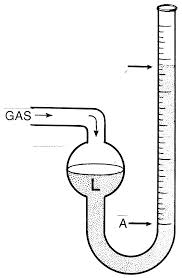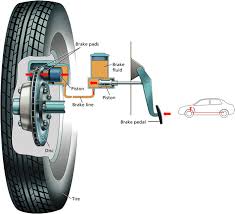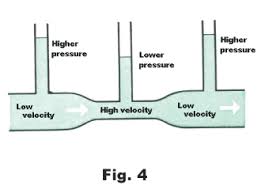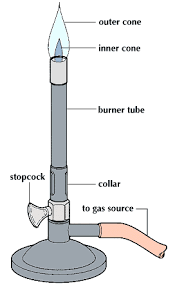pressure is the force which acts normal per unit area of contact.
P = F / A where P = pressure [Pa]
F = force [N]
A = area [m3]
3.2 Pressure in Liquids
Pressure in liquids are not dependent on the size or shape of the container, only on its depth.
P = hpg where P = pressure [Pa]
h = height of liquid [m]
p = density of liquid [kg m-3]
g = gravitational acceleration [m s-2]
3.3 Atmospheric and Gas Pressure
3.3.1 Atmospheric Pressure
Atmospheric pressure is measured by barometers.
fortin barometer
(simple mercury barometer)
aneroid barometer
Atmospheric pressure measured by a simple mercury barometer can be calculated using the formula P = hpg.
Standard atmospheric pressure at sea level is usually 76 cm Hg or 10 m water. it can also be expressed as 1 bar.
(Note : cm Hg is an accepted unit of atmospheric pressure. Other similar units involving different liquids are also accepted)
For example :
Given that h = 76 and the density of mercury is 13 600 kg m-3.
Answer :
Atmospheric pressure = 76 cm Hg
State the answer in Pascal :
P =hpg = 0.76(13 600)(10) = 103 360 Pa.
3.3.2 Gas Pressure
Gas pressure can be measured using manometer and Bourdon gauges.




 1) A hydraulic machine uses a hydraulic pump to transfer hydraulic liquid from one
1) A hydraulic machine uses a hydraulic pump to transfer hydraulic liquid from one
vessel into a large cylinder to create a movement.
2) The above diagram shows a hydraulic pump used to move the arm of a crane.
Archimedes’ principle dictates that when an object is partially or fully immersed in a
fluid, the object undergoes a buoyant force which is equal to the weight of the fluid
displaced.
where V = volume of fluid displaced [m3]
ρ = density of fluid [kg m-3]
g = gravitational acceleration [m s-2]
If the object is floating stationary:
Weight of object = Weight of fluid displaced.
3.5.1 Submarine
The buoyant force acting on the submarine is always the same because the weight of fluid
displaced is always the same.
When water is pumped into the ballast tank, the weight of the submarine increases.
When the weight of the submarine is greater than the buoyant force, the submarine sinks.
When water is pumped out of the ballast tank and replaced with air, the weight of the submarine decreases. When the weight of the submarine is less than the buoyant force, the submarine floats.
3.5.2 Hydrometer
A hydrometer is used to measure the relative density of a liquid.
When the hydrometer floats stationary on the surface of the liquid,
where m = mass of the hydrometer [kg]
*The higher the hydrometer floats, the denser the liquid.
*The lower the hydrometer floats, the less dense the liquid.
3.5.3 Hot air balloon
1) A hot air balloon displaces a large volume of air.
2) When the weight of the balloon is less than the upward thrust, the hot air balloon will
move upwards.
3.5.4 Ships
Ships are marked with Plimsoll lines at the sides as a guide on the maximum load the
ship can bear in different conditions.
3.6 Bernoulli's Principle.
Bernoulli’s principle dictates that when the velocity of a flowing fluid increases, the
pressure at that point decreases.
Uniform tube
a) when a uniform tube with one end stopped is filled with water, the levels in all three vertical tubes are the same.
water pressure at A = water pressure at B = water pressure at C
b) when the stopper is removed, it is found that the water levels are decreasing.
water pressure at A > water pressure at B > water pressure at C
This is because water flows from high pressure to low pressure.
Venturi tube


- As the aerofoil shape cuts through the air, the air is
forced to travel at a higher speed on top of the
aerofoil compared to below the aerofoil.
- The high velocity area causes the air to have low
pressure.
- Therefore, the higher pressure area pressures
against the aerofoil towards the lower pressure area
causing a lifting force.

- Carburetor mixes petrol and air for burning
in the engine cylinder.
- When air flows through the narrower part of
the tube, the velocity increases thus the
pressure decreases. An area with low
pressure is formed at X.
- The atmospheric pressure, which is greater,
pushes the petrol out from the jet.
- Petrol and air are mixed to create a spray.

- Gas flows out through the narrow jet at a very high velocity.
- A low-pressured area is formed at X.
- The air outside at atmospheric pressure flows in and mixes
with gas to light it.
- Oxygen supply which is enough from the air will ensure a
complete burning to produce a hotter flame and less
luminous.
For example :
Given that h = 76 and the density of mercury is 13 600 kg m-3.
Answer :
Atmospheric pressure = 76 cm Hg
State the answer in Pascal :
P =hpg = 0.76(13 600)(10) = 103 360 Pa.
3.3.2 Gas Pressure
Gas pressure can be measured using manometer and Bourdon gauges.
Manometer
Bourdon gauge
In manometers, pressure can be calculated based on pressure equilibrium.
For example :
Gas pressure = Atmosphere pressure + hpg
3.4 Pascal's Principle
Pascal's principle dictates that pressure which exerted onto the surface of a fluid in a closed container will be transferred uniformly throughout the entire fluid.
F1 / A1 - F2 / A2
All hydraulic system are built based on Pascal's Principle.
3.4.1 Hydraulic jack.
1) when the lever is pushed downwords, valve A closes while valve B opens.
2) Pressure is transferred to the larger cylinder and creates a large force to lift the car.
3) When the lever is pulled upwards, valve B closes while valve A opens. The hydraulic oil flows out from the tank to fill the space in the small cylinder.
4) As every movement downwards by the lever creates a small movement upwards for
the large piston, the lever needs to be pushed and pulled repeatedly before the car can
be raised to a certain height required.
5) The car can be lowered down by opening the release valve so that the hydraulic oil
can flow back into the tank.
3.4.2 Hydraulic brake
1) When the driver steps on the brake pedal, the piston in the main cylinder transfers
pressure through the hydraulic oil in the cylinders.
2) Pressure is transferred uniformly through the hydraulic oil.
3) The pistons in the slave cylinders are larger, therefore a large amount of force is
transferred to the brake pads.
4) The brake pads transfer the large amount of force onto the disc so that the rotation of
the tire is slowed down.
3.4.3 Hydraulic pump
vessel into a large cylinder to create a movement.
2) The above diagram shows a hydraulic pump used to move the arm of a crane.
3.5 Archimedes' Principle
Archimedes’ principle dictates that when an object is partially or fully immersed in a
fluid, the object undergoes a buoyant force which is equal to the weight of the fluid
displaced.
Buoyant force = Weight of fluid displaced.
= Vpg
where V = volume of fluid displaced [m3]
ρ = density of fluid [kg m-3]
g = gravitational acceleration [m s-2]
If the object is floating stationary:
Weight of object = Weight of fluid displaced.
3.5.1 Submarine
The buoyant force acting on the submarine is always the same because the weight of fluid
displaced is always the same.
When water is pumped into the ballast tank, the weight of the submarine increases.
When the weight of the submarine is greater than the buoyant force, the submarine sinks.
When water is pumped out of the ballast tank and replaced with air, the weight of the submarine decreases. When the weight of the submarine is less than the buoyant force, the submarine floats.
3.5.2 Hydrometer
A hydrometer is used to measure the relative density of a liquid.
When the hydrometer floats stationary on the surface of the liquid,
Weight of the hydrometer = Weight of the liquid displaced.
mg = Vpg
V = volume of liquid displaced [m3]
ρ = density of liquid [kg m-3]
g = gravitational acceleration [m s-2]
*The higher the hydrometer floats, the denser the liquid.
*The lower the hydrometer floats, the less dense the liquid.
3.5.3 Hot air balloon
1) A hot air balloon displaces a large volume of air.
2) When the weight of the balloon is less than the upward thrust, the hot air balloon will
move upwards.
3.5.4 Ships
Ships are marked with Plimsoll lines at the sides as a guide on the maximum load the
ship can bear in different conditions.
3.6 Bernoulli's Principle.
Bernoulli’s principle dictates that when the velocity of a flowing fluid increases, the
pressure at that point decreases.
Uniform tube
a) when a uniform tube with one end stopped is filled with water, the levels in all three vertical tubes are the same.
water pressure at A = water pressure at B = water pressure at C
b) when the stopper is removed, it is found that the water levels are decreasing.
water pressure at A > water pressure at B > water pressure at C
This is because water flows from high pressure to low pressure.
Venturi tube
3.6.1 Aerofoil
forced to travel at a higher speed on top of the
aerofoil compared to below the aerofoil.
- The high velocity area causes the air to have low
pressure.
- Therefore, the higher pressure area pressures
against the aerofoil towards the lower pressure area
causing a lifting force.
3.6.2 Carburetor
in the engine cylinder.
- When air flows through the narrower part of
the tube, the velocity increases thus the
pressure decreases. An area with low
pressure is formed at X.
- The atmospheric pressure, which is greater,
pushes the petrol out from the jet.
- Petrol and air are mixed to create a spray.
3.6.7 Bunsen Burner
- A low-pressured area is formed at X.
- The air outside at atmospheric pressure flows in and mixes
with gas to light it.
- Oxygen supply which is enough from the air will ensure a
complete burning to produce a hotter flame and less
luminous.

Quite Good notes to revice before exam
ReplyDelete